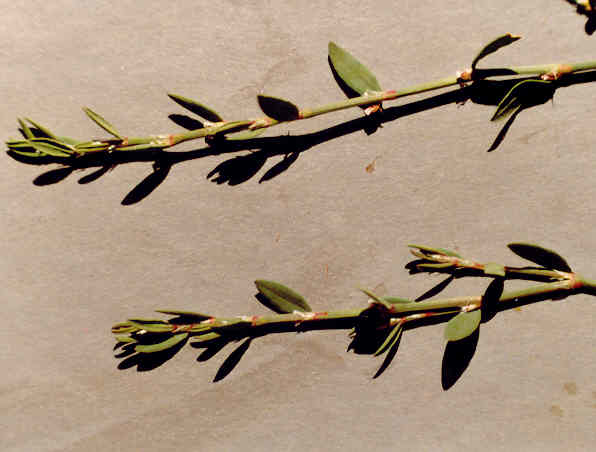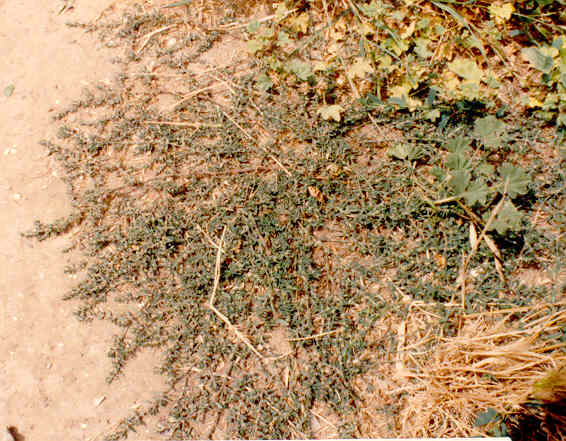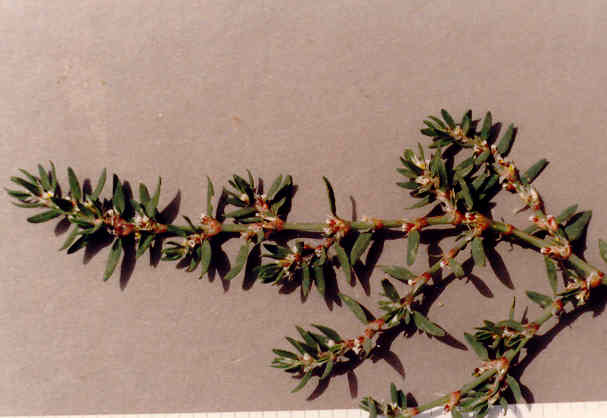
Polygonum arenastrum Bor.
=Polygonum aviculare
 |
Polygonum arenastrum Bor.=Polygonum aviculare
Polygonaceae (Buckwheat Family)EurasiaCommon Knotweed |
September Photo
Plant Characteristics:
Annual with prostrate or ascending bluish-green slender, terete stems,
not sharply angled, 1-12 dm. long; lvs. lanceolate
to almost oblong, 5-20 mm. long, blue-green, scattered to approximate,
not much reduced upward, joined with the ocreae and 1-nerved, mostly 2 or more
in the axils, short pedicelled; branch-lvs. much smaller than stem lvs.;
stipule-sheaths silvery, soon torn; fls. 1-5 in axillary clusters; calyx 2-3 mm.
long, greenish with pinkish to purplish margins, persistent, divided almost to
base; stamens 8, rarely 5; aks. dull or slightly shiny, 2-2.5 mm. long, somewhat
roughened.
Habitat:
Common weed in dooryards, waste places, etc.
May-Nov. Variable.
Name:
Greek, poly, many, and gonu, knee or joint, because of the
thickened joints on the stem. (Munz,
Flora So. Calif. 701). Latin,
avis, avicul, bird and arius, suffix added to noun stems to
form adjectives denoting belonging to. (Jaeger
26,32). Latin, arena, sand, a sandy place. (Jaeger 25).
Arenastrum may refer to a soil type in which the plant is found?
General:
Occasional in the study area. Photographed
on the North Star Flats. (my
comments). A decoction of the plant mixed with
oak bark is used as a substitute for quinine.
(Coon 235).
Whole large sections of many lawns are composed not of grass but of
knotgrass, which indicates hard soil, lazy lawn keepers, and careless walkers.
The slender pale green stems are usually prostrate and measure four
inches to two feet in length. Branches
emerge from the joints (or "knots"), which appear paler within the
sheath this common to the genus Polygonum. Though in 1809 William Pitt included knotgrass in his list of
the worst weeds of arable land, it has been found to have a number of uses.
Its juice stops nosebleed and a tea brewed from it has been used to stop
diarrhea and hemorrhages. The
American Indians had the patience to collect its tiny seeds and include them
with other seeds in a pinole. In Shakespeare's
day some thought this plant could inhibit the growth of children; thus his
"hindering knotgrass," in "A Midsummer Night's Dream."
(Crockett 175).
Used as an astringent and diuretic.
(Meyer 34). P.
aviculare is combined with P. arenastrum in the 1993 Jepson manual.
(my comment). P.
aviculare is very closely related to P. arenastrum, apparently
misapplied in California. (Hickman,
Ed. 1349).
Text Ref:
Hickman, Ed. 888, 1349; Munz, Calif. Flora 362; Munz, Flora So.
Calif. 703; Robbins et al. 134.
Photo Ref:
June 83 # 7A,8A; Sept 1 83 # 9.
Identity: by R. De Ruff, confirmed by F. Roberts.
First Found: June 1983.
Computer Ref: Plant Data 257.
Have plant specimen.
Last edit 5/20/05.
 |
 |
June Photo June Photo